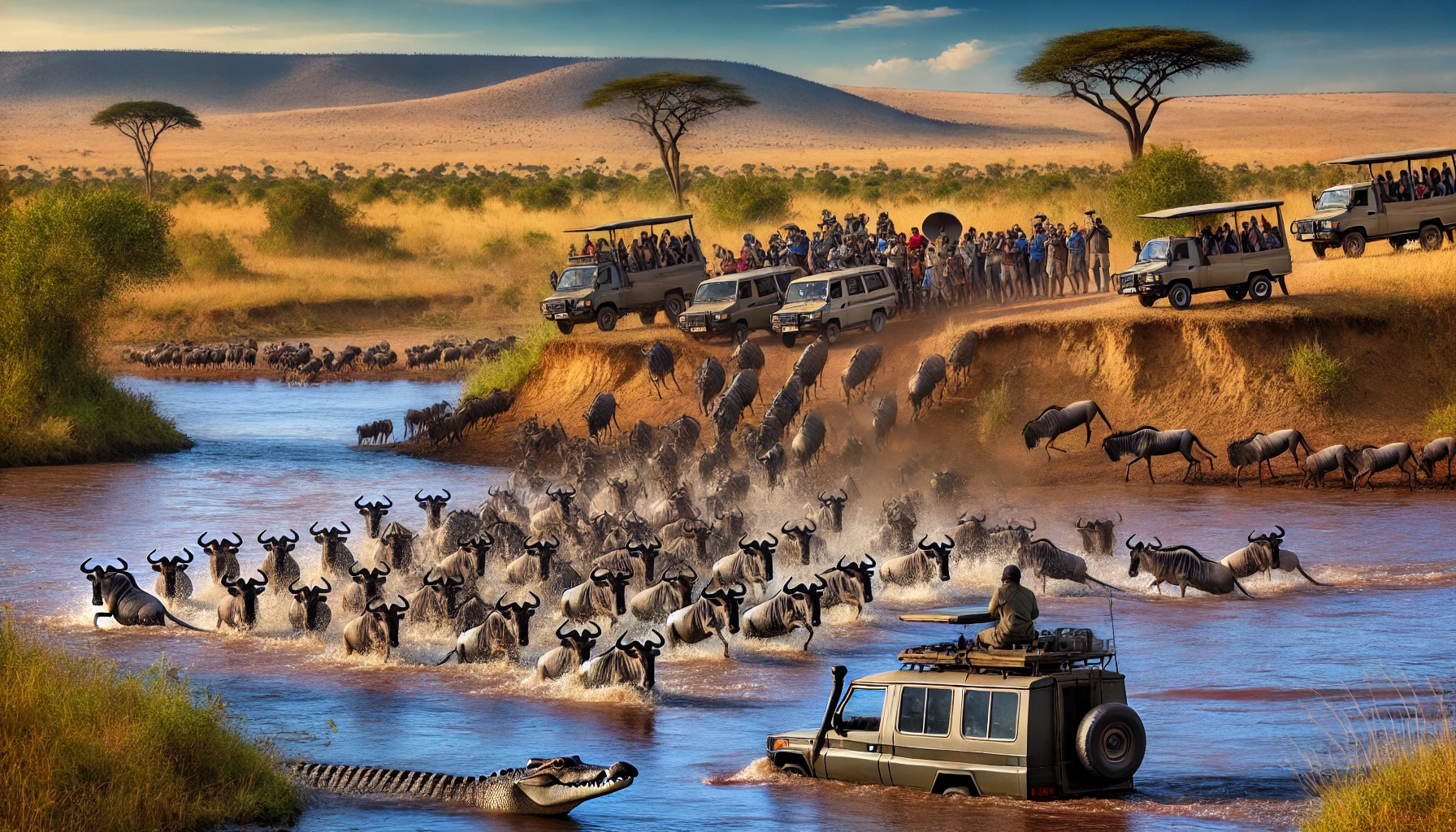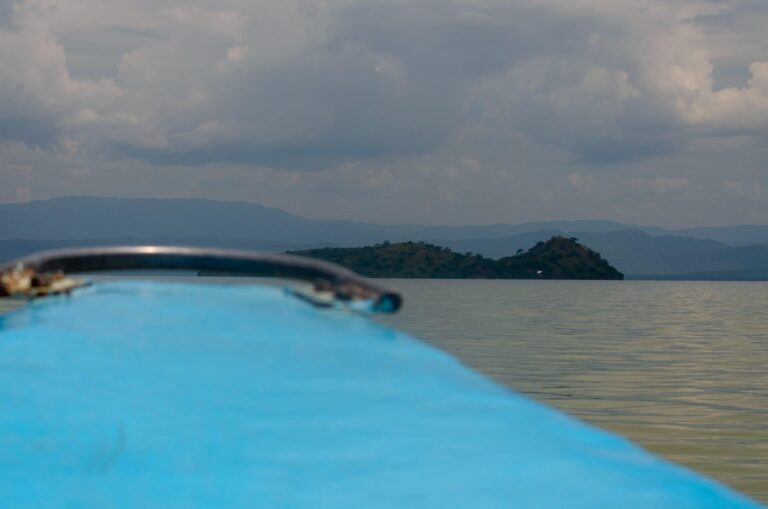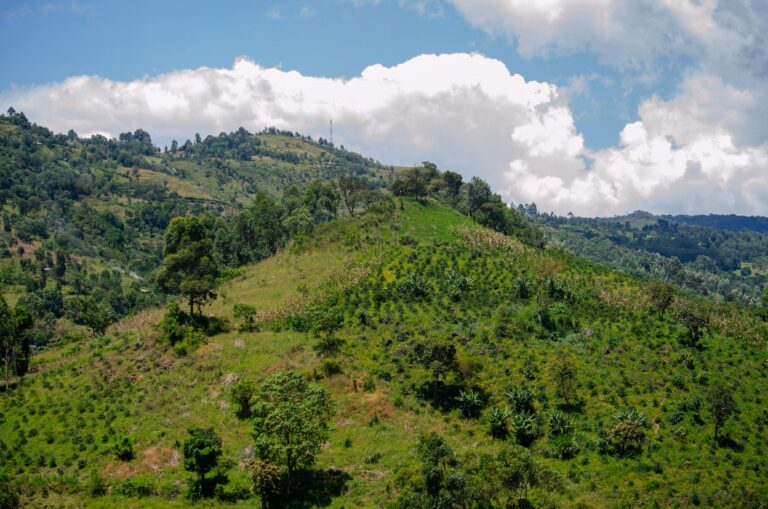The Wildebeest Migration, often referred to as “The Greatest Wildlife Show on Earth,” is an awe-inspiring natural event that attracts wildlife enthusiasts and photographers from across the globe. Spanning the vast savannahs of the Serengeti in Tanzania to the Masai Mara in Kenya, this annual spectacle of over 1.5 million wildebeests, accompanied by zebras and gazelles, offers unmatched opportunities for capturing dramatic wildlife scenes.
Table of Contents
Why the Wildebeest Migration is a Must for Photographers
The migration is not just about the sheer number of animals; it’s the drama, the predator-prey interactions, and the breathtaking landscapes that make it a goldmine for photographers.
- River Crossings: The highlight for many is the Mara River crossing, where wildebeests brave crocodile-infested waters.
- Predator Action: Lions, cheetahs, and hyenas follow the herds, creating opportunities for capturing raw, action-packed moments.
- Scenic Landscapes: The vast plains, dotted with acacia trees and dramatic skies, provide stunning backdrops.
🏞️ Ready to Conquer New Heights? 🏔️
🚀 Join Joe Photography and Safaris for thrilling hiking adventures across Kenya! Meet new friends, explore breathtaking trails, and create unforgettable memories. 🌿✨
🎒 Join Our Hiking WhatsApp Group 🚀Hikes. Adventures. Friendships. Memories. 🌍
Best Times and Locations for the Migration Safari
The migration is a year-round phenomenon, but specific periods are better for photography, depending on the stage of the migration:
1. Calving Season (January to March)
- What to Capture: Newborn calves, predator hunts, and the lush green Serengeti plains.
- Location: Southern Serengeti and Ndutu area in Tanzania.
2. Grumeti River Crossings (May to June)
- What to Capture: Herds crossing the Grumeti River and predators waiting in ambush.
- Location: Western Serengeti, Tanzania.
3. Mara River Crossings (July to September)
- What to Capture: The dramatic crossings at the Mara River, chaotic stampedes, and crocodile attacks.
- Location: Northern Serengeti in Tanzania and Masai Mara in Kenya.
4. Return Journey (October to December)
- What to Capture: Herds moving southward and predator-prey interactions during the dry season.
- Location: Central Serengeti in Tanzania.
What to Expect on a Wildebeest Migration Photo Safari
A migration safari is designed to maximize photography opportunities while ensuring a comfortable experience.
- Game Drives: Early morning and late afternoon drives are perfect for golden-hour shots.
- Mobile Camps: Stay in tented camps that move with the herds for optimal positioning.
- Professional Guides: Guides experienced in wildlife behavior help you anticipate action for the perfect shot.
The Great Migration Safari Highlights
Prime Location
Our camp is strategically located within the Maasai Mara reserve, placing you at the heart of the migration action. Situated along the Mara River, near one of the key crossing points, our location offers the unique advantage of witnessing wildebeest crossings directly from the camp. Unlike other areas crowded with tourists, our serene and exclusive setting ensures a more intimate wildlife experience.
Specialized Photographic Vehicles
We provide state-of-the-art photographic vehicles designed with photographers in mind. These vehicles feature open sides for unobstructed views and ample space for flexibility while shooting. Each participant is allocated an entire row of seats, ensuring comfort and freedom of movement. Provisions for beanbags and clamps are integrated into the vehicle’s open sides and roof, offering stable support for your equipment and enhancing the quality of your shots.
Lens Hire Services
For your convenience, we offer a lens hire service directly from our Maasai Mara base. This eliminates the hassle of arranging rentals in your home country and managing their delivery and return. Additionally, it helps you avoid challenges with airline carry-on weight restrictions. Our inventory includes 300mm and 400mm f/2.8 lenses with matching 1.4x converters, available for both Canon and Nikon mounts, enabling you to capture the perfect shot of the Great Migration.
By combining a prime location, tailored vehicles, and top-tier lens rental options, our safari ensures a seamless and unforgettable photography experience.
Photography Tips for Capturing the Migration
Achieving stunning images of the migration requires preparation, technique, and a keen eye for detail.
1. Gear Essentials
- Camera Body: A DSLR or mirrorless camera with high ISO performance is ideal.
- Lenses:
- Telephoto lens (100–400mm) for wildlife action.
- Wide-angle lens for landscapes and herds.
- Tripod or Monopod: Stabilization for long zooms or low-light conditions.
2. Master the Settings
- Shutter Speed: Use a fast shutter (1/1000 or faster) for action shots.
- Aperture: Keep it wide (f/2.8–f/5.6) for subject isolation and beautiful bokeh.
- ISO: Adjust according to lighting, but modern cameras handle higher ISOs well.
3. Capture the Drama
- Anticipate Action: Watch for movement cues like wildebeests gathering at riverbanks.
- Include Predators: Show the tension of the predator-prey dynamic.
- Focus on Details: Don’t just shoot the herd; capture close-ups of expressions and interactions.
4. Use the Light
- Golden Hour: Early morning and late afternoon offer soft, diffused light.
- Backlighting: Create silhouettes during sunrise or sunset for dramatic effect.
Packing List for a Migration Photo Safari
Here’s what to bring for a successful trip:
- Camera Equipment: Include extra batteries and memory cards.
- Clothing: Neutral-toned safari gear, a wide-brim hat, and comfortable shoes.
- Accessories: Binoculars, sunscreen, and insect repellent.
Why Choose Kenya for Your Photo Safari
While the migration spans both Tanzania and Kenya, the Masai Mara is an especially iconic destination for photography:
- Accessibility: Easily reachable from Nairobi with daily flights and road options.
- Rich Wildlife: The Mara offers more consistent predator sightings.
- Dramatic Crossings: The Mara River crossings are legendary for their intensity and chaos.
FAQs on the Great Migration Photo Safari
Where is your camp located in the Maasai Mara?
Our camp is strategically situated along the Mara River, near one of the main wildebeest crossing points. This prime location allows guests to witness the Great Migration directly from the camp, away from the crowded tourist areas.
What makes your photographic vehicles special?
Our vehicles are designed specifically for photographers. They feature open sides for unobstructed views, ample space for equipment, and provisions for beanbags and clamps. Each guest gets a full row of seats to ensure maximum comfort and flexibility while shooting.
Can I rent professional camera lenses at the camp?
Yes, we offer professional lens hire at our Maasai Mara base. We currently stock 300mm and 400mm f/2.8 lenses with 1.4x converters for both Canon and Nikon mounts. This service eliminates the hassle of traveling with heavy equipment and navigating airline restrictions.
What is the best time to book a safari for the Great Migration?
The Great Migration typically occurs between July and October, with river crossings being most frequent during this period. We recommend booking your safari early to secure your spot during this peak season.
What other services do you provide for photographers?
In addition to specialized vehicles and lens hire, we provide expert guides with experience in wildlife photography. They ensure you are in the best locations at the right times for optimal photographic opportunities.
Also Read:



